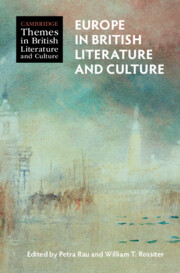Book contents
- Europe in British Literature and Culture
- Cambridge Themes in British Literature and Culture
- Europe in British Literature and Culture
- Copyright page
- Contents
- Illustrations
- Contributors
- General Editor’s Preface
- Acknowledgements
- Introduction
- Part I Zones of Influence
- Chapter 1 The Mediterranean
- Chapter 2 France
- Chapter 3 Central Europe
- Chapter 4 Ireland
- Chapter 5 Scandinavia
- Chapter 6 The Balkans and Ruritania
- Part II Pan-European Moods and Movements
- Part III Cultural Transfers
- Part IV Anxious Neighbourhoods, Uncertain Futures
- Index
Chapter 5 - Scandinavia
from Part I - Zones of Influence
Published online by Cambridge University Press: 06 June 2024
- Europe in British Literature and Culture
- Cambridge Themes in British Literature and Culture
- Europe in British Literature and Culture
- Copyright page
- Contents
- Illustrations
- Contributors
- General Editor’s Preface
- Acknowledgements
- Introduction
- Part I Zones of Influence
- Chapter 1 The Mediterranean
- Chapter 2 France
- Chapter 3 Central Europe
- Chapter 4 Ireland
- Chapter 5 Scandinavia
- Chapter 6 The Balkans and Ruritania
- Part II Pan-European Moods and Movements
- Part III Cultural Transfers
- Part IV Anxious Neighbourhoods, Uncertain Futures
- Index
Summary
This chapter examines consistent patterns and changing trends in British representations of Scandinavia throughout the nineteenth century. It demonstrates how Scandinavia became not only an alternative destination for British travellers but also the source of new literary forms and motifs which inspired and fuelled contemporary debates in British society. Its case studies are Mary Wollstonecraft’s Letters Written during a Short Residence in Sweden, Norway, and Denmark (1796), Harriet Martineau’s Feats on the Fjord (1841), and Maria Sharpe Pearson’s writings on Ibsen’s work published in the British press (1889–94). These texts demonstrate the growing attraction of the Scandinavian landscape and the so-called cultural (re)discovery of Old Norse literature and mythology as well as Scandinavia’s rising literary reputation from the 1880s onwards thanks to the international impact of realist and naturalist works by Scandinavian authors, notably Henrik Ibsen. Ultimately Scandinavia offered the ‘allure of accessible difference’ as the region was and continues to be perceived as both geographically and culturally close – and yet far away.
Keywords
- Type
- Chapter
- Information
- Europe in British Literature and Culture , pp. 85 - 99Publisher: Cambridge University PressPrint publication year: 2024

